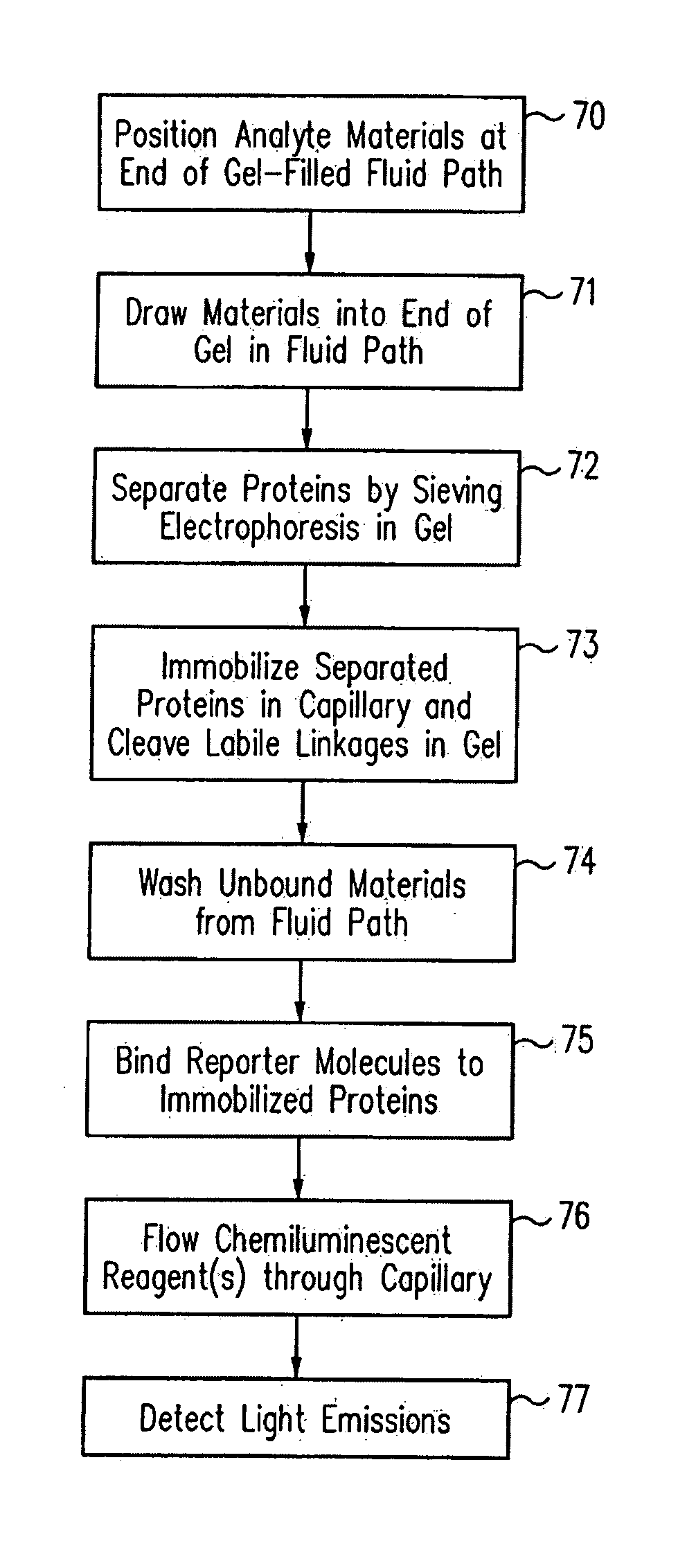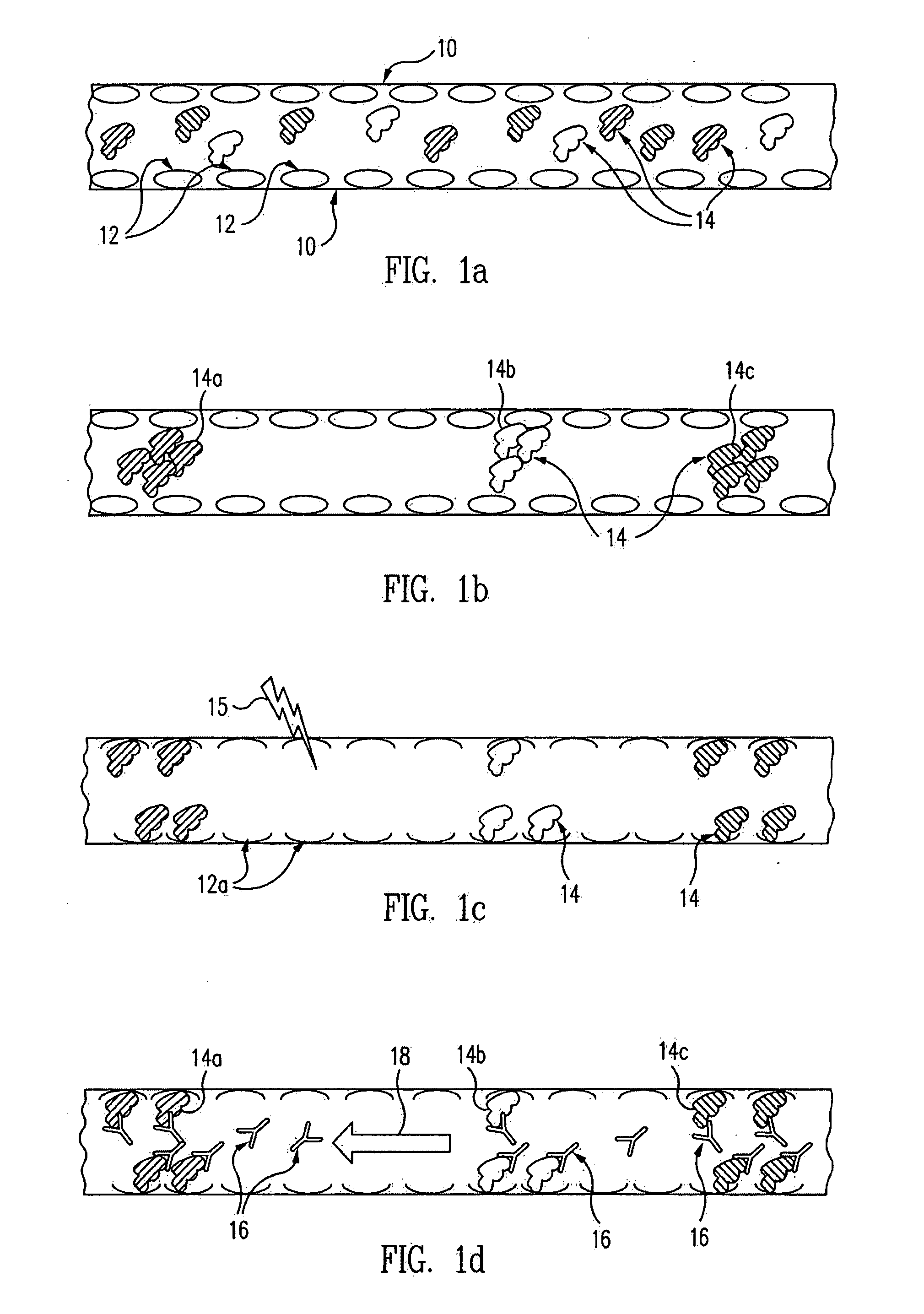Methods and devices for analyte detection
a technology of analyte detection and medical devices, applied in the field of medical devices and kits for analyte detection, can solve the problems of inconvenient, expensive, or other deficiencies of current assay protocols, and the extensive handling of the components of the technique,
- Summary
- Abstract
- Description
- Claims
- Application Information
AI Technical Summary
Benefits of technology
Problems solved by technology
Method used
Image
Examples
example 1
Fluorescence Detection of Green Fluorescent Protein (GFP)
[0175] Preparation of GFP sample for analysis: In a microcentrifuge tube, 40 μL of DI water, 1 μL of GFP at 1 mg / ml (Part number 632373, Beckton-Dickinson, San Jose, Calif., USA), 5 μL of bioPLUS pI 4-7 (Bio-World, Dublin, Ohio), and 2 μL of ATFB-PEG cross-linking agent (2 mM) were combined. The ATFB-PEG cross-linking agent consists of 15,000 MW branched polyethylene glycol (product number P4AM-15, SunBio, Anyang City, South Korea) in which each branch terminus was derivatized with an ATFB (4-azido-2,3,5,6-tetrafluorobenzoic acid) functionality (product number A-2252, Invitrogen Corporation, Carlsbad, Calif.).
[0176] Preparation of capillary: 100μ I.D.×375μ O.D. Teflon-coated fused silica capillary with interior vinyl coating (product number 0100CEL-01, Polymicro Technologies, Phoenix, Ariz.) was surface grafted on its interior with polyacrylamide containing 1 mole percent benzophenone. 4 cm sections of this capillary materia...
example 2
Chemiluminescence Detection of GFP
[0182] Preparation of GFP sample for analysis: In a microcentrifuge tube, 40 μL of DI water, 1 μL of GFP at 1 mg / ml (Part number 632373, BD Biosciences, San Jose, Calif., USA), 5 μL of bioPLUS pI 4-7 (Bio-World, Dublin, Ohio), and 2 μL of ATFB-PEG cross-linking agent (2 mM) were combined. The ATFB-PEG cross-linking agent consists of 15,000 MW branched polyethylene glycol (product number P4AM-15, SunBio, Anyang City, South Korea) in which each branch terminus was derivatized with an ATFB (4-azido-2,3,5,6-tetrafluorobenzoic acid) functionality (product number A-2252, Invitrogen Corporation, Carlsbad, Calif.).
[0183] Preparation of capillary: 100μ I.D.×375μ O.D. Teflon-coated fused silica capillary with interior vinyl coating (product number 0100CEL-01, Polymicro Technologies, Phoenix, Ariz.) was surface grafted on its interior with polyacrylamide containing 1 mole percent benzophenone. 4 cm sections of this capillary material were cleaved from longer...
example 3
Fluorescent Detection of Horse Myoglobin
[0189] Preparation of sample for analysis: In a microcentrifuge tube, 40 μL of DI water, 2 μL of 4 mg / ml purified horse myoglobin (Part number M-9267, Sigma-Aldrich, St. Louis, Mo., USA) myoglobin solution, 5 μL of Pharmalyte ampholyte pI 3-10 (Sigma, St. Louis), and 2 μL of ATFB-PEG cross-linking agent (2 mM) were combined. The ATFB-PEG cross-linking agent consists of 15,000 MW branched polyethylene glycol (product number P4AM-15, SunBio, Anyang City, South Korea) in which each branch terminus was derivatized with an ATFB (4-azido-2,3,5,6-tetrafluorobenzoic acid) functionality (product number A-2252, Invitrogen Corporation, Carlsbad, Calif.).
[0190] Preparation of capillary: 100μ I.D.×375μ O.D. Teflon-coated fused silica capillary with interior vinyl coating (product number 0100CEL-01, Polymicro Technologies, Phoenix, Ariz.) was surface grafted on its interior with polyacrylamide containing 1 mole percent benzophenone. 4 cm sections of this ...
PUM
 Login to View More
Login to View More Abstract
Description
Claims
Application Information
 Login to View More
Login to View More - R&D
- Intellectual Property
- Life Sciences
- Materials
- Tech Scout
- Unparalleled Data Quality
- Higher Quality Content
- 60% Fewer Hallucinations
Browse by: Latest US Patents, China's latest patents, Technical Efficacy Thesaurus, Application Domain, Technology Topic, Popular Technical Reports.
© 2025 PatSnap. All rights reserved.Legal|Privacy policy|Modern Slavery Act Transparency Statement|Sitemap|About US| Contact US: help@patsnap.com



